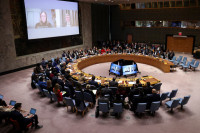Columns
The workplace after Covid-19
Remote working has emerged as a strong option in managing offices, even in the public sector.
Hiramani Ghimire
Covid-19’s most profound impact is being observed in how we manage our work. The increasing tendency to decouple the workforce from the workplace is creating both challenges and opportunities for managers. Amidst fears of a decline in productivity, the experience of this past year shows that employees working from flexible locations, including their own homes, are becoming more productive than previously thought. As a result, remote working has emerged as a strong option in managing offices, even in the public sector.
The world of work is undergoing four major shifts in this context. First, the concept of a fixed location for an office is giving way to the idea of hybrid working. Second, the managerial focus has moved from efficiency to resilience, involving provisions for organisational resources to maintain supply chains. Third, control as a management principle is losing ground to trust, leading to disintermediation and de-layering of decision-making. Finally, organisational leaders are increasingly emphasising the need to complement technical skills with social skills such as emotional intelligence. It is very important that Nepali managers, in both public and private domains, adapt their organisational strategies to these emerging trends.
Flexible working
The workplace—or the office—evolved in the 19th century as a result of the industrial revolution. In today’s service-oriented economy, people can work differently. Much of office work can be carried out remotely and from home. The influential writer Fareed Zakaria notes in his recent book Ten Lessons for a Post-Pandemic World that work is coming back to home, which it was like for much of history. In other words, the world of work is moving "back to the future".
Experience of the past year or so shows that employees working from home can be as productive as those working from the office, if not more. The myth of productivity decline has been dispelled. In a McKinsey research (2020), for example, 41 percent of respondents said they were more productive working at home than they had been before, with 28 percent saying that they were as productive. The UK Chartered Institute of Personnel Development finds that 30 percent of British employees felt they worked more hours at home. A US Federal Work-Life Survey shows that teleworkers are 16 percent more engaged, 19 percent more satisfied, and 11 percent less likely to leave than onsite workers. Closer to home in Nepal, managers have indicated that their fear of 50 percent efficiency loss was unfounded, and whatever loss was there could be attributed to logistics and connectivity problems.
Working from home is a good response to the pandemic, but it cannot be an alternative to the office forever. Going back to the 19th-century idea of the office as a fixed location is neither efficient nor desirable. The time has come for a hybrid model. It involves some combination of working remotely and from an office. The hybrid model is a plan that incorporates a mix of office-based and remote work in an employee's time plan. It enables employees to work from different locations—home, on the go or the office.
Many people tend to associate hybridity with organisations in the private sector. This may be attributed to the fact that private enterprises were the first to resort to remote work arrangements when the pandemic struck. Meanwhile, public sector organisations are catching up. International experience of the past one and a half years shows that governments in several countries are formalising hybrid office arrangements.
The United Kingdom, known as the mother of parliaments, was the first country to introduce the concept of a "hybrid parliament" in April 2020. For this, Members of Parliament adopted a set of "hybrid proceeding measures" which enabled them to take part in oral questions and statements. They were also able to participate virtually or in-person in substantive proceedings under these arrangements. Brazil, Mongolia, Maldives, Canada and Poland have also adopted a hybrid parliament with different stages of development.
Other government businesses are also being conducted from hybrid offices. In April this year, the UK government decided to open "drop-in" offices in 10 cities outside of London to enable Whitehall staff to work from any of these offices. Civil servants can work efficiently and flexibly from home without the costly overheads of office spaces and time-consuming commuting for employees. This also eases traffic congestion, thereby reducing the impact of climate change, even if in a limited way. In India, the Department of Personnel and Training has issued a protocol for work from home for civil servants with flexi-time schedules. These examples show that the model is not only applicable but also desirable in government organisations.
Experience in Nepal
Covid-19 has affected the business of government in Nepal equally badly. During the past 18 months or so, Nepalis have had to face complete or partial lockdowns several times. This impacted the delivery of public services, including critically important ones. But there was a silent reluctance to introduce the hybrid model. For example, when several countries were finalising their working procedures for a hybrid parliament, Nepal decided to prorogue the House in the wake of some Covid-19 cases in April 2020.
This is not to suggest that government agencies are not aware of the benefits of remote working. The pandemic has augmented their "intention" to offer services online. And several government departments have introduced IT-based measures to enable people to access their services. This is in line with the Digital Nepal Framework, which the government has adopted to “leverage the potential of digital technologies to drive accelerated growth”. This shows that there is significant technical capacity within the government system.
It is said that opportunities are usually disguised as problems. The pandemic has given public sector agencies an opportunity to use available technologies for improving business processes through flexible working arrangements, including the hybrid model. For this, two things need to happen simultaneously: The development of digital infrastructure and management capacity to use it. While these will take time, one step could be taken immediately, which is to formalise and build on what is already happening—hybrid work.




 5.14°C Kathmandu
5.14°C Kathmandu















